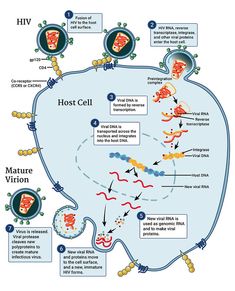The HIV Life Cycle
The HIV Life Cycle
In order for viruses to reproduce, they must infect cells in the body. Viruses are not technically alive: They are like a brain without a body. So in order to make more copies of itself, a virus must hijack our cells and use them to make new viruses. But how does that happen?
Your body constantly makes new skin and blood cells, and each cell often makes new proteins in order to stay alive and reproduce. Viruses hide their own DNA in the DNA of the cell. So when the cell tries to make its own proteins, it accidentally makes new viruses as well.
HIV can infect many types of cells in the body, but it mostly infects cells in the immune system. Once infected, a cell can produce hundreds of new copies of HIV.
Several kinds of immune cells have proteins on their surface, called CD4 receptors. HIV searches for these because the CD4 protein helps the virus bind to the cell. The main target for HIV is a white blood cell called a T4 lymphocyte, or “T helper cell”. The T4 cell is responsible for warning your immune system that there are invaders present.
Step 1: Binding
The outside of HIV has an outer shell (envelope) of proteins, fats and sugars. Inside, it carries its genes and special enzymes.
Proteins on the outside of HIV (also called receptors) are strongly attracted to and connect to the CD4+ receptors on a T4 cell. When HIV binds to a CD4+ receptor, other proteins on the cell’s surface get activated, allowing HIV to fuse to and enter the cell. Entry into the cell can be blocked by a class of HIV meds called entry inhibitors.
Step 2: Reverse Transcription
HIV’s genes are RNA while the genes inside human cells are DNA. So, in order for the virus to infect the cell, a process called “reverse transcription” makes a DNA copy of the HIV’s RNA. This is done with one of HIV’s enzymes called reverse transcriptase. The new HIV DNA is also called “proviral DNA.”
Reverse transcription can be blocked by one class of HIV meds called nucleoside reverse transcriptase inhibitors (NRTIs) and another class called non-nucleoside reverse transcriptase inhibitors (NNRTIs).
Step 3: Integration
The new HIV DNA is then carried into the cell’s nucleus (center), where the cell’s DNA is kept. At this point, another HIV enzyme called integrase hides the HIV DNA into the cell’s DNA. Then, when the cell tries to make new proteins for itself, it accidentally makes new HIV.
Integration can be blocked by a class of HIV meds called integrase inhibitors.
Step 4: Transcription
Once the HIV DNA is inside the cell’s nucleus, it directs the cell to produce new HIV. Special enzymes will eventually create new genetic material called messenger RNA or mRNA. (Think of this new RNA as instructions for making new HIV.)
Transcription can be blocked by antisense antivirals or transcription inhibitors. However, these classes of drugs are in the earliest stage of research and are not FDA approved.
Step 5: Translation
Since mRNA carries instructions for making new viral proteins, each section of the mRNA relates to making a different part of HIV. So, as the full strand of mRNA is processed, it gets transformed or “translated” into all the viral proteins needed to make a new virus.
Step 6: Viral Assembly and Maturation
The final step begins with the assembly of new virus. First, the long strings of proteins translated from the mRNA are then cut up into smaller proteins by the HIV enzyme called protease. These proteins become different parts of HIV, such as structural pieces (capsid, matrix, etc.) or enzymes (integrase, protease, etc.).
Next, once all the new viral proteins get assembled, they enter through and bud off the host cell to create a new virus. The new HIV then takes some time to mature, which can go on to infect new cells.
Viral assembly can be blocked by a class of HIV meds called protease inhibitors



.jpg)
Comments
Post a Comment